Top News
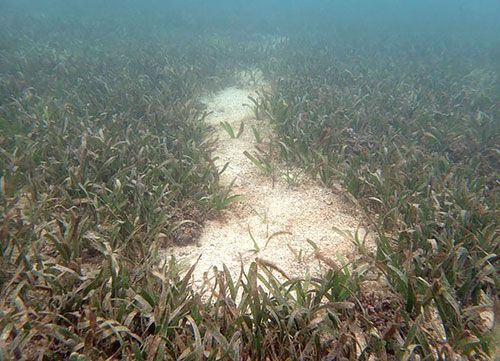
April 1, 2020 Ryukyu Shimpo
(Tokyo) On March 31, the Ministry of the Environment compiled its results from FY 2019 surveys of the state of habitation of the dugong, which is a Natural Monument of Japan, and revealed that it found new marks thought to be dugong feeding trails near Hateruma Island and Irabu Island. 2019 was also the first year surveyed in which no feeding trails were seen off the coast of Kayo in Nago.
The Ministry of the Environment carried out surveys on Hateruma Island and the surrounding area after receiving information from an interview with a relevant organization in FY 2018 that a dugong had been spotted there.
Marks thought to be dugong feeding trails were found at 64 locations near Irabu Island. There were eight locations where a high density of feeding trails was seen. Interviews with local residents resulted in four reports of observation of a large animal thought to be a dugong.
Marks thought to be feeding trails were seen at three locations near Hateruma Island. Since no new plant growth was seen, it was estimated that a dugong was feeding there very recently. Interviews also revealed that one dugong had been seen.
Meanwhile, the ministry was not able to capture a photograph of a dugong at any location. A survey experimentally conducted near Irabu Island using new technology for detecting dugong DNA in the water did not reveal any DNA detection.
The Ministry of the Environment plans to continue conducting surveys on the basis of expert opinion that there is a high likelihood, based on the presence of feeding trails, that dugongs are present in these areas.
Meanwhile, surveys at three locations near the northern part of Okinawa Island, where surveys have been conducted regularly for some time, did not reveal any feeding trails in the sea near Kayo, where trails were observed each year up until FY 2018. The Okinawa Defense Bureau also did not observe any feeding trails in its recent survey there.
No feeding trails were seen near Kouri or Sumuide either.
The Ministry of the Environment stated that there is a possibility that the dugongs moved to a different feeding location, and also pointed out that feeding trails can sometimes disappear temporarily. It announced that, while knowing that the endeavor will be difficult, it plans to keep investigating signs of dugong activity.
(English translation by T&CT and Sandi Aritza)
Go To Japanese

April 9, 2020 Ryukyu Shimpo
JetStar Japan announced April 9 that they are suspending all flights between Shimojishima Airport and Narita Airport, as well as all connecting flights from April 10 through May 6.
As a result, Shimojishima Airport Management, the firm that operates the Miyako Shimojishima Airport Terminal, has decided to close the terminal for the same period of time.
Shimojishima Airport has five flights that travel to and from Narita each week, as well as three weekly connecting flights.
(English translation by T&CT and Sam Grieb)
Go To Japanese
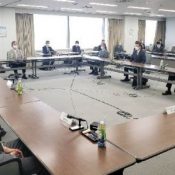
April 2, 2020 Ryukyu Shimpo
On April 1 it came to light that mistakes were found in 20 portions of the explanatory documents from the Ministry of Defense’s “technical investigative commission” panel of experts. This technical investigative commission was established to address ground improvement of the soft seabed as part of Futenma replacement facility construction in Henoko, Nago City. At the 6th meeting of this technical investigative commission on April 1, the Ministry of Defense explained the content of amendments made to the documents. However, the commission chair Osamu Kiyomiya, an emeritus professor of Waseda University, said that this “does not affect the discourse up to this point”, and no other commission member raised any other opinion.
Out of the five meetings of the technical investigative commission that took place between last year in September and this year in March, the mistakes in the explanatory documents were only confirmed at the fourth meeting following the initial meeting.
When a contractor through the Okinawa Defense Bureau closely inspected the documents, errors in the numerical values relating to the stability of the seawalls and diagrams that do not reflect proper calculation results were detected, among other things.
Even in a graph expressing the strength of cohesive soil there was a portion which was amended. A contact person at the Ministry of Defense explained that this was amended “so as to not lead to an overestimation of the strength” of the soil.
Although the necessary quantities of earth for use in ground reinforcement and land reclamation were also erroneous, the Ministry of Defense insists that when comparing investigation results before and after the amendments, there is no effect on the overall processes, and procurement of materials is still possible.
Emeritus Professor Masaaki Tateishi of Niigata University, who sent a questionnaire to the technical investigative commission concering the soft seabed investigation, pointed out: “Up until now the technical investigative commission has overlooked erroneous entries in the documents, the lack of integrity therein, et cetera. As a result of receiving identification [of errors] from our research group, another close investigation was conducted and amendments were determined to be necessary. It feels arbitrary”.
Civil engineer Tsuyoshi Kitaueda, who brought to light the existence of the soft seabed through a freedom of information request to the Okinawa Defense Bureau, said: “The fact that the technical investigative commission did not identify these errors makes it apparent just how unreliable its deliberations have been up to this point”.
(English translation by T&CT and Erin Jones)
Go To Japanese
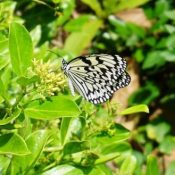
April 2, 2020 Ryukyu Shimpo
On April 1, the tree nymph was established as the Prefectural Butterfly of Okinawa, the prefecture’s newest symbol. Previously, there were six established Prefectural Symbols, including the Prefectural Emblem, the Prefectural Flower (deigo flower), and the Prefectural Tree (ryukyumatsu or Okinawa pine tree). The Prefectural Butterfly is Okinawa’s seventh symbol, and the first symbol established in 48 years.
Okinawa is the second prefecture to choose a Prefectural Butterfly following Saitama. The tree nymph is part of the family Nymphalidae, and is one of the biggest butterflies in Japan. The tree nymph is widely distributed throughout Okinawa and familiar to Okinawans. The butterfly has white wings with black spots and the pupa is yellow.
Establishing the Prefectural Butterfly will be an opportunity to deepen understanding of Okinawa’s unique natural abundance through its well-known fauna, beginning with the tree nymph, and to work to spread awareness and common knowledge. This will lead to a stronger desire to grow and protect the prefecture’s natural environment.
The Selection and Advisory Committee established by the prefectural government recommended the tree nymph be chosen after it received the most votes in the “Haberu General Election” held by the Prefectural Residents for Establishing Okinawa’s Prefectural Butterfly Association and Ryukyu Shimpo Co. Ltd. in 2017.
(English translation by T&CT and Ellen Huntley)
Go To Japanese
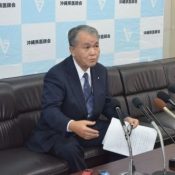
April 2, 2020 Ryukyu Shimpo
Due to the continued spread of COVID-19, the Okinawa Medical Association (Tetsuyoshi Asato, committee chair) announced April 2 that, with the opening of the tomb sweeping festival (shimi) season taking place this weekend, they are asking people to refrain from returning home from outside the prefecture, and to keep gatherings small.
At a press conference held at the press club in the Okinawa Prefectural Office, association vice-chair Testuya Miyazato asked for understanding from Okinawans, saying that the continued flow of people into the prefecture increased the danger brought by the disease, imploring, “Observing culture is important.
We are not saying that we are completely closing off entry, however we strongly ask that special caution be exercised.”
They are especially requesting that (1) those who reside in Tokyo and Osaka not return to Okinawa to participate, (2) to choose a representative member for grave cleaning to keep gathering small, and (3) to definitely not allow those with signs off illness such as a fever to participate.
Since shimi is an event that takes place outside the home, the large number of people who gather at a specific time to talk and share a meal increase the risk of infection.
A rapid increase in patients could lead to an inability to maintain adequate healthcare services, and the association’s announcement comes as a result of numerous healthcare facilities asking people to refrain from participating.
Toru Itokazu, Okinawa Prefecture’s general director of health and hygiene said, “We agree with the serious dangers identified by healthcare facilities. We hope that the people of Okinawa will understand and act accordingly.”
(English translation by T&CT and Sam Grieb)
Go To Japanese
April 12, 2020 Ryukyu Shimpo
Fire-extinguishing foam containing PFOS, a type of carcinogenic organic fluorine compound, was discovered to have escaped outside of MCAS Futenma and onto the streets of Ginowan, polluting the rivers and falling on the streets in residential neighborhoods. This includes the foam floating over the heads of children at a preschool on the following day, April 11. This is an absolutely inexcusable incident.
At the very least, the U.S. military should allow Okinawa Prefecture and Ginowan City entrance into the base to conduct an investigation to identify the cause of the incident as well as responsible parties.
The Japanese government should also immediately and strongly demand that the U.S. should immediately remove all fire-extinguishing material that contains PFOS.
The fire extinguishing foam was activated by a fire-extinguishing system in one of the bases hangars, and leaked out through the south side of the base via a water drainage system to the surrounding area.
The drainage system connects directly to Hiyara River, which flows out into Makiminato Bay and into the ocean off the western coast. The foam also floated up into the air, falling into the Ginowan residential neighborhoods of Maehara and Ojana.
PFOS has been known to cause cancer, and its use is banned in Japan due to the associated health risks. It is also regulated internationally, and both Japan and the U.S. have been working to replace all fire extinguishing material with replacements that do not contain PFOS.
Despite this, there was a similar incident at MCAS Futenma in December, 2019, when fire-extinguishing material containing PFOS leaked out from the base. Taking into account the current incident, it is clear that the U.S. is not adequately progressing in their replacement of the hazardous material.
This is not limited to MCAS Futenma either; there was another incident where a high content of PFOS was discovered in a river adjacent to Kadena Air Base.
An investigation by Okinawa Prefecture found that the concentration rose significantly after water had drained out from the base.
The prefecture requested permission to enter the base to conduct a survey due to the high likelihood that the source of the contamination was Kadena Air Base, however they were denied by the U.S. military.
The toxic foam danced down the streets of neighborhoods, and polluted the waters white. Even so, why is it so difficult for the local authorities to investigate its source?
The biggest obstacle is the Japanese-American Status of Forces Agreement (SOFA).
Despite the pollution, the base cannot be entered for an investigation without permission from the U.S. military, so the reality is that there is no visibility for the Japanese government, local authorities, or area residents.
The inside of the bases are effectively an extraterritorial area.
While the U.S. forces in Japan are supposed to conform to the environmental regulations set bilaterally by Japan and the U.S. in the Japan Environmental Governing Standards (JEGS), the U.S. military stubbornly sticks to their own internal rules, so the effectiveness of these standards are severely lacking. The laws that were put in place to protect the living conditions for those in proximity to the military installations target things such as noise pollution, and do not cover things like soil and water contamination.
On April 12, it will have been 24 years since Japan and the U.S. made an agreement for the return of MCAS Futenma.
However, no steps have been taken towards the return, and the training flights continue while the base is surrounded by homes.
Residents are regularly subjected to the dangers of aircraft accidents and environmental pollution. Nothing has been done to change the danger to resident’s health and safety.
Japan and the U.S. must continue conversations towards the end of operations at MCAS Futenma, and the return of all base area without relocating facilities within the prefecture. A policy to “remove the danger” can mean only this.
(English translation by T&CT and Sam Grieb)
Go To Japanese
April 13, 2020 Ryukyu Shimpo
Ginowan City, Okinawa—It was agreed 24 years ago that the U.S. Marine Corps base in Futenma would be closed and the site would be returned to Okinawa. In the meantime, the base burden on Ginowan residents has not lessened. The number of military aircraft flights, which operate day and night, is increasing, especially for transient aircrafts. The city receives frequent complaints from residents every day.
While complaints about interruptions of television broadcasts (specifically, land-based digital television broadcasts) persist, recent complaints have focused on the noise levels of the American and Japanese national anthems that are played early in the morning on base.
The number of takeoffs and landings of U.S. aircrafts at Futenma totaled 15,285 in FY2019, excluding the month of March, for which the numbers are yet to be determined. Of these, transient aircrafts accounted for 2,439 flights, exceeding the previous year. Meanwhile, the city received 507 complaints in FY2019, of which 77 were noise complaints related to the national anthems, while 13 were about interruptions of television broadcasts.
The city will gather complaints related to television broadcast interruptions; construction will begin in FY2020 to implement countermeasures, using subsidies from the Ministry of Defense.
(English translation by T&CT and Monica Shingaki)
Go To Japanese
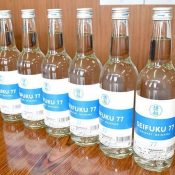
April 11, 2020 Ryukyu Shimpo
(Ishigaki) On April 10, Seifuku Distillery (based in Ishigaki, Okinawa; president: Kenryu Kanna) held a press conference at Ishigaki City Hall and announced that it will start manufacturing awamori called “Seifuku 77” having a 77% alcohol content.
The awamori will be sold as a beverage, but contains a similar alcohol content to alcohol disinfectants, which have been hard to come by as a result of the spread of COVID-19 infection. The company plans to start manufacturing the awamori on April 14.
Since the awamori meets certain criteria under the Fire Service Act, only the amount for which orders are placed will be manufactured, and the product will be sold at the company’s Miyara office in Ishigaki. The company does not plan to sell the product in stores. Since it cannot be transported by aircraft, it is expected to be supplied only within the Yaeyama islands. It will be manufactured for a limited time until the COVID-19 situation ends.
President Kanna said, “We are not manufacturing it for disinfectant use, but we tried to think of what we could do as a manufacturer on the island.” Ishigaki’s Mayor Yoshitaka Nakayama, who it is said requested that the company manufacture this product, shared his hopes for the product, saying, “In an emergency, I think availability of an awamori that can serve as a substitute for alcohol disinfectants will help people have peace of mind.”
The awamori will be sold in 600-milileter bottles priced at 2,500 yen (including tax). The company plans to start taking orders next week. For more information, contact Seifuku Distillery at 0980-84-4118.
(English translation by T&CT and Sandi Aritza)
Go To Japanese
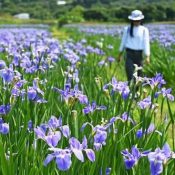
April 9, 2020 Ryukyu Shimpo
In Kijoka, Ogimi Village, the Iris ochroleuca is in full bloom and the flower fields are awash in purple. On the morning of April 8, families and shutterbugs arrived at the flower fields, enjoying the drive and the early summer weather. Yoshiko Okonogi, 69, who visited from Chatan, snapped photos of the bright-colored flowers and wild birds. She said, “I have been very impressed by the students of the local elementary school and their engagement in environmental observation activities. There are many types of wild birds [here] and the Iris ochroleuca is very beautiful.”
According to the Okinawa Meteorological Observatory, a low-pressure trough and front are expected to increase the chance of rain and clouds during the first half of next week. A high-pressure system is expected to move in later in the week, bringing mostly sunny weather.
(English translation by T&CT and Monica Shingaki)
Go To Japanese
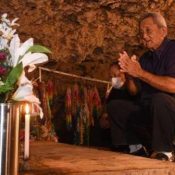
April 5, 2020 Ryukyu Shimpo
During the Battle of Okinawa, immediately following the U.S. military landing on Okinawa Island, on April 2, 1945, 83 residents of the island were gathered for “collective self-determination” (compulsory group suicide) at the natural cave Chibichiri-gama in Namihira, Yomitan Village. On April 4 this year, the Bereaved Family Association held a memorial service at the cave. Twenty-five people including survivor Take Uechi, bereaved family members, and concerned persons set up incense sticks in the cave, calmly held their palms together, and thought of their blood relatives who were lost in this tragic event 75 years ago.
This year, in a new style to prevent the spread of coronavirus, the service was only performed by bereaved family members and concerned persons, and attendees wore masks.
Tokuichi Yonaha, 77, from Tokeshi, Yomitan Village, who lost his grandparents on his mother’s side as well as his siblings, faced the alter and made an address in Uchinaguchi (Okinawan language) after offering incense. He said that even now, 75 years after the battle, “The seas, skies, land – all of Okinawa is an American possession. If we stay silent peace will not come”, and pledged, “We have inherited bitterness and regret from the victims who were taken [in Chibichiri-gama], we will not allow such a tragedy to take place a second time”.
President of the Bereaved Family Association Norio Yonaha, 65, responded to media after the memorial service and revealed that some bereaved family members participated in the service for the first time this year. He emphasized that as the population ages, passing on tradition to coming generations remains a problem, and said, “preserving peace is a major duty [of the Bereaved Family Association]. I hope these memorial services continue”. I hope that many people come to Chibichiri-gama as a place to learn about the preciousness of life”.
(English translation by T&CT and Erin Jones)
Go To Japanese
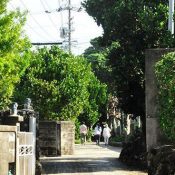
April 8, 2020 Ryukyu Shimpo
Nanjo – On April 7, due to the spread of novel coronavirus, representatives of Kudaka Island, Nanjo asked tourists to refrain from visiting the island. Nagayasu Hokama, head of Kudaka Ward, says that while the request is not intended to regulate entry to the island, “we have many elderly residents and we do not have a robust medical system.” He adds, “if a case of the virus is confirmed on the island, it will endanger the island’s existence. We ask that people refrain from visiting.”
The request will be in effect from April 8 through April 30, but may be changed depending on the situation.
If there is a change, it will be reported on Kudaka Island’s website, “Kudaka no shima jikan (Kudaka Island Time),” which can be accessed at https://kudaka-island.com/
Minami-Daito Request to Tourism Association: Refrain from Visiting
By Yoko Ikeda
Minami-Daito – On April 6, the Minami-Daito Novel Coronavirus Task Force (led by Mayor Kensho Nakada) held its third meeting at the village hall. With infections spreading domestically and internationally, the Task Force requested that tourists as well as business travelers on non-essential, non-urgent business refrain from visiting the island. These requests were made to the Village Tourism Association and the Village Commerce and Industry Association respectively. Hotels and other lodgings are moving toward not accepting reservations through the end of April.
Minami-Daito is a remote and isolated island with limited medical resources, unable to conduct PCR tests. Thus, if infections spread, the medical system could collapse. This possibility increases the sense of urgency. The Task Force asks residents to prevent the spread of the disease by wearing masks, washing their hands, and avoiding the 3 C’s: closed spaces, crowded places, and close-contact settings.
(English translation by T&CT and Ellen Huntley)
Go To Japanese









 Webcam(Kokusai Street)
Webcam(Kokusai Street)


